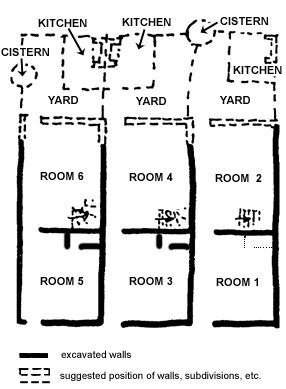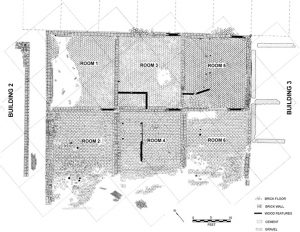Port Royal Building One

ARCHITECTURE OF BUILDING 1
BUILDING 1 is a well-built brick building, measuring 53 ft. wide and 47 ft. deep. It consists of six ground-floor rooms divided into three separate two-room units, each of which appear to have housed a distinct business or activity. The original building consisted of Rooms 1, 3, and 5. A back two story addition was added to what was formerly the yard. The volume of fallen bricks on the floors and the remains of the ground floor wood components of stairwells in the corners of Rooms 3 and 5 shows conclusively that was also at least one upper storey, which probably held living quarters. A comparable stairwell was probably present in Room 1.
The front rooms (Rooms 1, 3 and 5) are aligned with the south side of Lime Street. They are connected, respectively, by an interior wooden doorway to Rooms 2, 4, and 6, which were added later (much reducing the size of the yards). Plastered, whitewashed walls and herringbone-patterned brick floors comprise the front three rooms. The bricks of the back-room floors, in contrast, were laid out end-to-end.
Based on the pattern found elsewhere in Port Royal, each of the building’s three units most likely had a separate yard, with a kitchen or ‘cook-room’ with a brick hearth. The cisterns in the yards were shared with adjoining yards and were fed by rainwater from nearby roofs.
FUNCTION(S) OF BUILDING 1
Rooms 1 and 2: From the large assortment of leather scraps, shoe soles, a wooden lathe, and some planks, it appears that this unit housed a combination cobbler/wood turner’s shop. Large quantities of cut animal bones and sea turtle shells suggest also that butchering and/or food preparation occurred in the unit’s back area.
Rooms 3 and 4: The large number of recovered artifacts associated with the selling and consumption of alcohol suggest that this unit appears to have been a used as a tavern. At least 60 dark-colored glass liquor bottles, as well as jugs, tankards, and kegs, were recovered from this area.
Rooms 5 and 6: The artifact assemblage consisted of masses of unused clay tobacco pipes, glass bottles, and pewter plates. This suggests that this unit was used as a combination pipe/wine shop.


